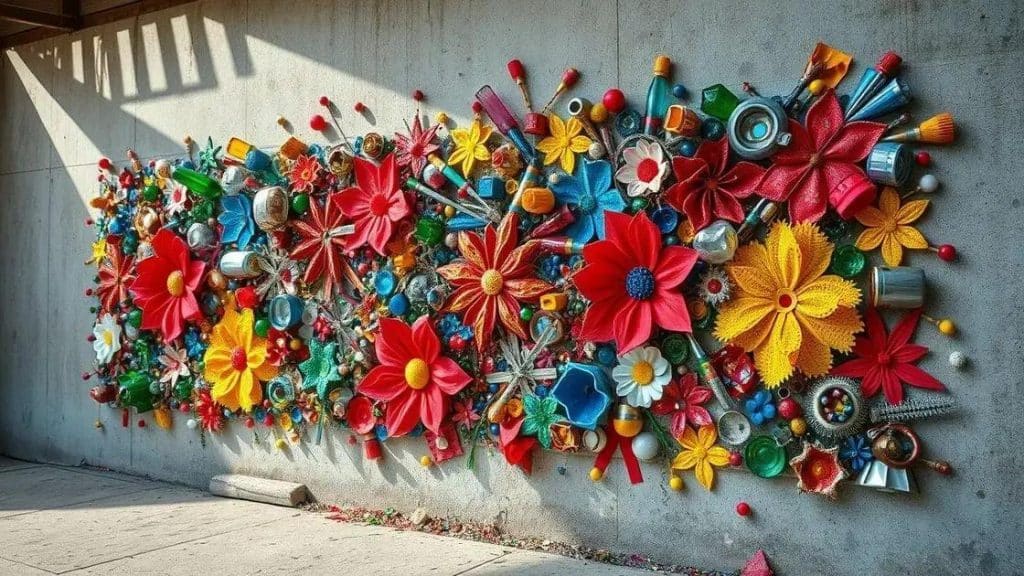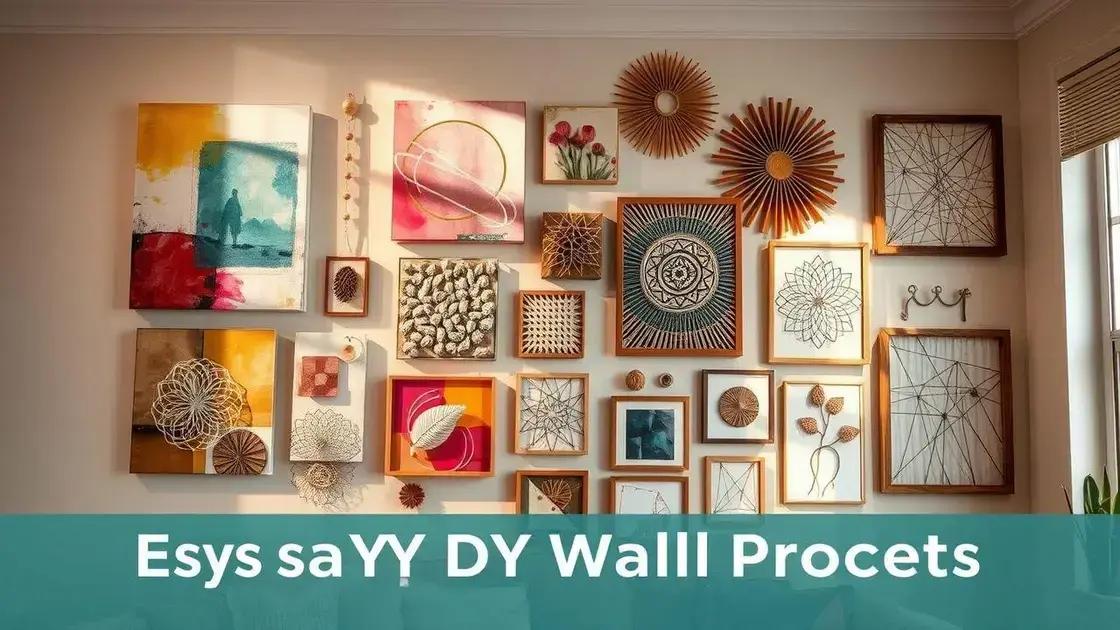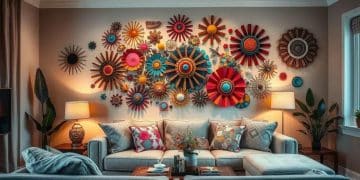DIY wall art with recycled materials: creative ideas

DIY wall art with recycled materials allows you to create unique, eco-friendly artworks using items like old newspapers, cardboard, and plastic bottles, enhancing your decor while promoting sustainability.
DIY wall art with recycled materials opens up a world of creativity! Have you ever thought about how everyday items can become stunning art pieces? Let’s dive in and explore some fun ideas.
Why choose recycled materials for wall art?
Choosing recycled materials for your wall art is a wonderful way to express your creativity while being environmentally friendly. It’s not just about saving money; it’s also about making a statement. By using items that would otherwise end up in a landfill, you contribute to sustainability and promote the idea of reusing resources.
Benefits of Using Recycled Materials
There are many reasons to consider using recycled materials for your art projects. Not only is it an eco-friendly choice, but it also allows for unique and creative expressions.
- Promotes sustainability and reduces waste.
- Encourages creativity by mixing different textures and colors.
- Offers a personal touch, as each piece is one-of-a-kind.
Using these materials can also be a fun activity to share with friends or family. You can gather items around your home, such as old bottles, cardboard, or fabric scraps. This way, you turn trash into treasure, inviting more people to join the DIY movement.
Different Types of Recycled Materials
There are countless items you can use to create stunning wall art. Some popular options include:
- Old newspapers or magazines that can be collaged.
- Wood scraps from previous projects.
- Plastic bottles can be transformed into imaginative designs.
Each material has its own character and story, making your artwork even more special. When you combine various elements, you create a rich tapestry that captures attention.
Incorporating recycled materials not only enhances your creativity but also inspires others. When people see your art, it might spark their interest in exploring their own artistic talents while being kind to the planet. So gather those materials and let your imagination run wild!
Easy DIY projects for beginners

Starting with easy DIY projects is a fantastic way for beginners to dive into the world of wall art. These projects are simple, fun, and require minimal materials. You can create beautiful pieces that reflect your style without any complex techniques.
Simple Canvas Art
One of the easiest projects is creating canvas art. Just take a blank canvas and some acrylic paint. You can use brushes, sponges, or even your hands to apply the paint. Experiment with colors and textures, and don’t worry about making it perfect. The beauty of DIY is in the process!
Recycled Paper Collage
A paper collage is another great project for beginners. Gather old magazines, newspapers, or even gift wrap.
- Cut out shapes or images that speak to you.
- Use a glue stick to arrange them onto a piece of heavy paper.
- Layer different pieces to create depth and interest.
This can be a fun way to express yourself while recycling materials.
Another simple idea is using natural elements. Collect twigs, leaves, or small stones from your garden. You can paint them or leave them as they are and arrange them on a canvas or a wooden board. Connecting with nature through art can be incredibly rewarding and calming.
Framed Fabric Art
Framing fabric is also an easy way to make wall art. You can use leftover fabric scraps, old clothes, or even linens. Place the fabric in an old frame, and you have instant artwork! Choose textures and patterns that match your room to create a cohesive look.
Additionally, consider making string art. Just hammer nails into a wooden board in a shape of your choice, then wrap string or yarn around the nails to create a stunning visual. It’s simple, yet effective, making it a perfect project for beginners.
Crafting techniques to enhance your artwork
Using different crafting techniques can take your wall art to the next level. These methods can add depth, texture, and a unique touch to your pieces. Exploring various ways to enhance your artwork allows you to express yourself more fully and creates stunning visuals.
Layering Materials
One effective technique is layering. By using different materials, you can create a multi-dimensional look. For example, you can place fabric over paper or use cardboard pieces to add height. Layering can attract attention and make your art pop.
Mixed Media Approaches
Another great technique is mixed media, which involves combining multiple types of materials like paint, fabric, and natural elements. Blending these diverse items can result in exciting combinations.
- Integrate glitter or beads for sparkle.
- Incorporate natural items like leaves or stones.
- Try using metallic or textured paints for extra depth.
These elements add a tactile quality to your art, making viewers want to reach out and touch it.
Using stencils can be an enjoyable way to enhance your pieces too. They allow for precise designs and patterns. You can create your own stencils or purchase them from a craft store. Painting over the stencil can lead to clean, professional-looking shapes that make your art stand out.
Experimenting with Color
Don’t forget the power of color! Experimenting with various color schemes can dramatically change the feel of your artwork. Warm colors like red and orange convey energy, while cool colors such as blue and green offer calmness. Mixing complementary colors can create a vibrant effect and add contrast.
Lastly, using texture can significantly elevate your artwork. You can achieve this by incorporating items like sand, fabric, or even pastes to create a raised effect. The added texture draws interest and invites viewers to take a closer look.
Tips for displaying your recycled wall art

Displaying your recycled wall art creatively can enhance your space and showcase your unique style. Understanding the best ways to hang and present your artwork is essential for making a statement. Let’s explore some tips to highlight your art effectively.
Choosing the Right Location
Start by finding the perfect spot for your wall art. Consider the lighting in the area. Natural light can brighten your artwork, making colors pop. Avoid direct sunlight, as it may fade materials over time. Look for walls that are bare and could use a touch of creativity.
Mixing Artwork Styles
When displaying multiple pieces, consider mixing different styles and sizes. This can create a dynamic gallery wall.
- Combine your recycled art with other types, like framed photographs.
- Vary the sizes and shapes of the pieces, balancing larger items with smaller ones.
- Use different hanging methods, such as frames, clips, or even strings.
This mix can showcase your artistic range and make your wall more engaging.
Consider using floating shelves to display smaller pieces or 3D items. Shelves allow you to change the arrangement without putting more holes in the wall. Displaying pieces at various heights can add interest and depth.
Framing and Mounting
Don’t overlook the importance of framing. A well-chosen frame can elevate the appearance of your recycled artwork. Use frames that complement the materials and colors in your art. Alternatively, you can also mount pieces directly on the wall for a more modern feel.
Another option is to hang your artwork with clothespins on a wire or string, giving it a playful and casual look. This method makes it easy to swap out pieces and keep your display fresh.
Lastly, consider creating a mood by arranging your art based on themes. Use colors, topics, or even seasons to guide your choices. This cohesive approach can transform a simple wall into a powerful storytelling space.
In conclusion, creating and displaying recycled wall art is not just a fun activity; it’s a wonderful way to express creativity and promote sustainability. From selecting unique materials to showcasing your art in eye-catching ways, every step allows you to personalize your space. By experimenting with different crafting techniques and display methods, you can transform ordinary items into extraordinary pieces of art that inspire others. So, gather those recycled materials, unleash your imagination, and start creating beautiful wall art today!
FAQ – Frequently Asked Questions about DIY Wall Art with Recycled Materials
What types of recycled materials can I use for wall art?
You can use items like old newspapers, cardboard, plastic bottles, and fabric scraps to create amazing wall art.
How do I start a DIY wall art project?
Begin by gathering materials and choosing a simple project, like a collage or painting on canvas. Let your creativity guide you!
What are some tips for displaying my recycled wall art?
Choose a good location with natural light, mix different styles and sizes, and consider layering to create depth.
Can kids participate in making recycled wall art?
Absolutely! DIY wall art is a great family activity, allowing kids to express their creativity safely and enjoyably.





